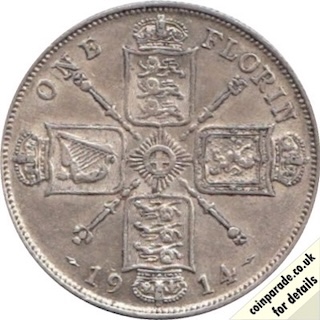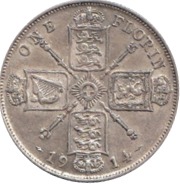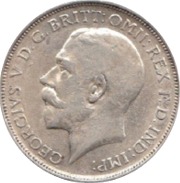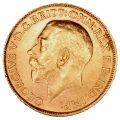
 The 1914 Florin - George V
The 1914 Florin - George VThe Reverse shows crowned cruciform shields separated by sceptres in the angles.
Edge is reeded.
 The Obverse shows a portrait of King George V by Australian Sir Edgar Bertram MacKennal.
The Obverse shows a portrait of King George V by Australian Sir Edgar Bertram MacKennal.Images used by permission of M J Hughes Coins
Mintage: 21,252,701 (may include coins in sets)
Minted at The Royal Mint
More information (monarch, year, mint, country, category) can be found below coin listings.
Below are some coins currently being offered on eBay. As an eBay Partner, We may be compensated if you make a purchase.
List items on:
List items on:
Remember 1914 ?
The Monarch is King George V. Prime Minister is H. H. Asquith (Liberal). US President is Woodrow Wilson (Democrat). World War One starts; on the 4th August 11.00pm Britain declares war on Germany after the German Army invades neutral Belgium; the Royal Navy is in action the very next day. By the end of the year the War was already claiming thousands of lives. Sir Ernest Shackleton sets sail on the Endurance from Plymouth in an attempt to cross Antarctica. Although Edward VII died in 1910, the start of WWI is taken as the end of the Edwardian Era.
George V (1910-1936)
 George V was King of the United Kingdom and the British Dominions, and Emperor of India, from 6 May 1910 until his death in 1936 and was King during World War 1. George was the second son of Albert Edward, Prince of Wales (later King Edward VII), and grandson of Queen Victoria. After his death he was succeeded by his eldest son, Edward VIII.
George V was King of the United Kingdom and the British Dominions, and Emperor of India, from 6 May 1910 until his death in 1936 and was King during World War 1. George was the second son of Albert Edward, Prince of Wales (later King Edward VII), and grandson of Queen Victoria. After his death he was succeeded by his eldest son, Edward VIII. In 1919-20, the Silver price rose dramatically so .925 silver coins began to made in 0.500 siver. Gold Sovereigns were produced in large quantities early in George's reign - over 30 million in 1911 and again in 1912, although there was no bullion sovereigns issued 1918-1924 (Commonwealth mints did continue mintage).
Category: Florins
The Florin is a 2 shillings coin, one-tenth fo a pound sterling. The British florin was issued from 1849 until 1967, with a final collectors coin dated 1970. After decimalisation it became the 10p piece.Specifications:
- Mass 11.31 g
- Diameter
- (1849) 28.0 mm
- (1851–1886) 30.0 mm
- (1887–1892) 29.5 mm
- (1893–1970) 28.5 mm
- Edge is Milled
- Composition:
- (1849–1919) 92.5% Ag
- (1920–1946) 50% Ag
- (1947–1970) Cupronickel. No silver.
Which Mint: The Royal Mint
The Royal Mint is the designated place for the UK to mint coins. It dates back well over 1000 years and is a Government-owned company. Formed in the reign of Alfred the Great about the year 886, during the period 1279-1812 it was generally referred to as The Tower Mint as it was housed at the Tower of London. The Master of The Royal Mint has included famous figures such as Sir Isaac Newton.
Since 2010 it has operated as Royal Mint Ltd, a company owned by HM Treasury, under an exclusive contract to supply all coinage for the UK although it also produces medals and coins for other countries. It is currently located at Llantrisant, Wales.
Country of Origin: United Kingdom
The United Kingdom (UK) is the Union of England, Scotland, Wales and Northern Ireland. It is often refered to as Great Britain (GBR). It has a long, rich history. The orignal coinage was Pounds, Shillings and Pence but since decimalisation on 15 February 1971, it is £1 = 100p, that is One Pound = 100 pence. The coinage of the UK is also a long history, the Royal Mint being established as long ago as 886AD when coins were hammered. Today there is perhaps 30 billion coins in circulation, and many (numismatic) collectors coins and sets are issued frequently in gold, silver and other metals.








